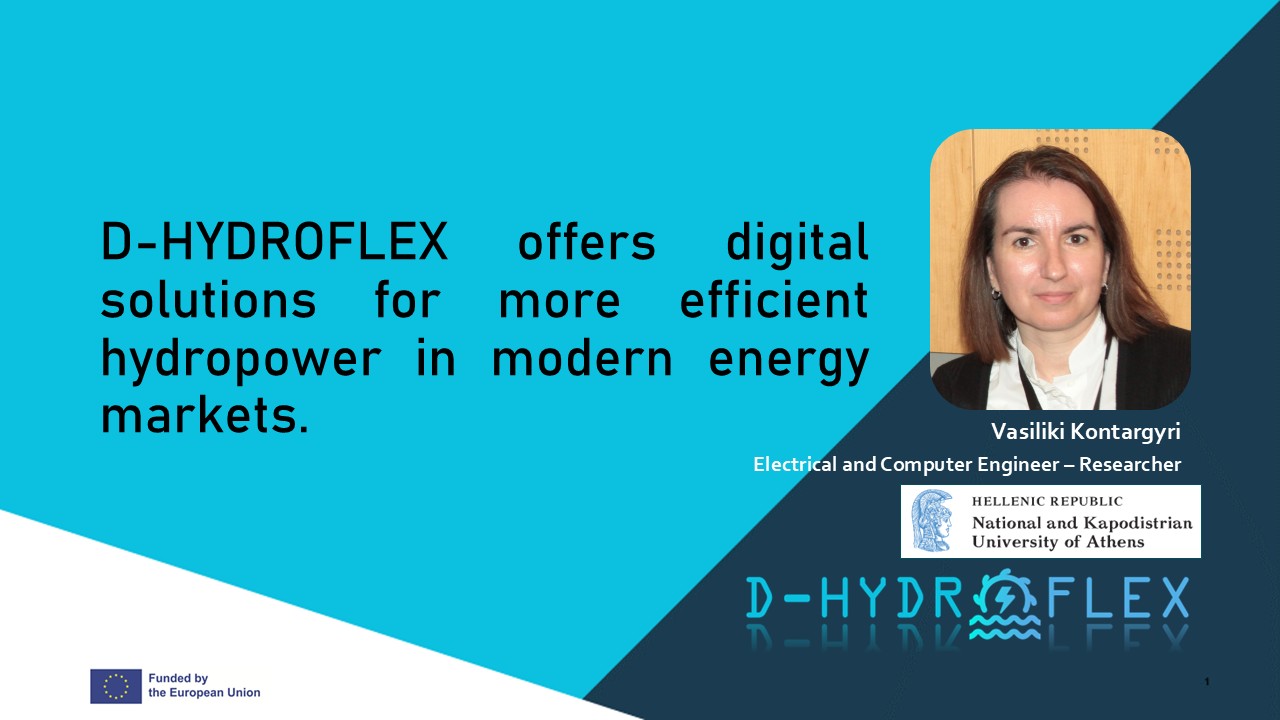Today, our blog hosts a short interview with Vasiliki Kontargyri from National and Kapodistrian University of Athens.
Vasiliki, welcome. We are delighted to host you to the #meettheD-HYDROFLEX team blog series with you. The National and Kapodistrian University of Athens (UoA) is contributing to D-HYDROFLEX project by identifying stakeholders, assessing hydropower flexibility, and advancing scientific excellence, while also supporting policy recommendations and participating in standardization activities.
Please, Vasiliki, tell us a few things for yourself to get to know you.
I am an Electrical and Computer Engineer with a 5-year diploma from the National Technical University of Athens in Greece (1997-2002). I hold a Ph.D. from the Division of Electric Power of the National Technical University of Athens (2002-2007). These last years, I am conducting post-doctoral research in the area of smart grids and high-voltage direct current power systems at the University of Athens and the University of West Attica, Greece. My area of expertise and research interests include topics on smart grids, high voltage systems, electric power transmission and distribution systems, grounding systems, electrical insulation and simulation models. My expertise is further demonstrated by my participation in over 30 national and European projects since 2002.
Q: Could you describe your company’s role on the project?
A: The National and Kapodistrian University of Athens (UoA) is one of four universities participating in D-HYDROFLEX. It is involved in the design of the D-HYDROFLEX Hydropower 4.0 toolkit, leading the task of identifying stakeholders and assessing the flexibility potential of hydropower plants. It will also communicate and disseminate the innovative results of the project and interact with the research and academic community, industry and the public through conferences, workshops and publications. In addition, the UoA is involved in scientific excellence and policy recommendations and is responsible for standardization activities. The UoA is the representative of D-HYDROFLEX in the BRIDGE WG Data Management.
Q: Please tell us more about why we need to think out of the box regarding hydroelectric power plants.
A: Hydroelectric power stations transform the hydraulic energy of natural or artificial watercourses into renewable electricity. It is the largest single source of low-carbon electricity – more than all other renewables combined – and provides a significant proportion of the world’s electricity. With its ability to deliver large amounts of low-carbon electricity on demand, hydropower is a key element in the creation of secure and clean electricity supply systems. Hydropower plants can be flexible because they can increase or decrease output in seconds or minutes to meet changing demand. Since most of the hydropower plants were built some decades ago, the digitalization of their operations can improve their efficiency, sustainability and environmental impact. D-HYDROFLEX aims to develop such technologies based on sensors, digital twins, AI, hybrid modelling, cloud-edge computing and machine vision to make hydropower plants more efficient, sustainable and competitive in modern energy markets.
Q: What are the main challenges of your work on the project, and how do you tackle them?
A: The reliability and resilience of electricity networks are fundamental to meeting electricity demand. In D-HYDROFLEX project, the main challenge is to achieve a higher level of flexibility and reliability in the existing hydroelectric power plants. Through interviews with prominent stakeholders in the EU hydroelectric landscape, a broad overview of the key challenges has been obtained and a list of technical, economic, sustainability and environmental requirements has been derived, which guide the design of D-HYDROFLEX. Furthermore, policy recommendations will be formulated based on feedback from relevant stakeholders on the challenges facing hydropower stations.
Q: What are your expectations from the project? What impact will the project have on the energy ecosystem?A: I am convinced that the D-HYDROFLEX project with its digital and environmental solutions will lead to failure-free and sustainable operation of the hydroelectric power plants at maximum efficiency. Without neglecting the cyber-resilience of the tools developed, D-HYDROFLEX is expected to optimise operation planning, predictive maintenance, real-time monitoring and market participation. D-HYDROFLEX will help Member States to maximise existing RES resources, both by increasing the use of the existing hydroelectric fleet and by demonstrating the ability of existing, refurbished and new hydroelectric plants to support higher levels of RES penetration from sources such as wind and PV, as well as hybridised hydroelectric plants.
Vasiliki, thank you very much for this interview. It was a pleasure having you with us today.
One more #meettheD-HYDROFLEX blog story is completed.
Stay connected to learn more on D-HYDROFELX workforce and activities. Followed us on LinkedIn and on X.
Please subscribe here to our newsletter to keep updated on our activities.





